 nominate Lesser Black-backed Gull (L. f. fuscus)
nominate Lesser Black-backed Gull (L. f. fuscus)
(last update:
Amir Ben Dov (Israel)
Hannu Koskinen (Finland)
Mars Muusse (the Netherlands)
fuscus 1cy July
fuscus 1cy Aug
fuscus 1cy Sept
fuscus 1cy Oct
fuscus 1cy Nov
fuscus 1cy Dec
fuscus 2cy Jan
fuscus 2cy Feb
fuscus 2cy March
fuscus 2cy April
fuscus 2cy May
fuscus 2cy June
fuscus 2cy July
fuscus 2cy Aug
fuscus 2cy Sept
fuscus 2cy Oct
fuscus 2cy Nov
fuscus 2cy Dec
fuscus 3cy Jan
fuscus 3cy Feb
fuscus 3cy March
fuscus 3cy April
fuscus 3cy May
fuscus 3cy June
fuscus 3cy July
fuscus 3cy August
fuscus 3cy Sept
fuscus 3cy October
fuscus 3cy Nov
fuscus 3cy Dec
fuscus 4cy Jan
fuscus 4cy Feb
fuscus 4cy March
fuscus 4cy April
fuscus 4cy May
fuscus 4cy June
fuscus 4cy July
fuscus 4cy Aug
fuscus 4cy Sept
fuscus 4cy Oct
fuscus 4cy Nov
fuscus 4cy Dec
fuscus ad Jan
fuscus ad Feb
fuscus ad March
fuscus ad April
fuscus ad May
fuscus ad June
fuscus ad July
fuscus ad Aug
fuscus unringed Aug
fuscus ad Sept
fuscus ad Oct
fuscus ad Nov
fuscus ad Dec
Distribution of the subspecies of the Lesser Black-backed Gull Larus
fuscus in sub-Saharan Africa
- HENRIK KYLIN, HENK BOUWMAN, AND MICHEL LOUETTE -
Capsule The wintering area of the nominate subspecies of Lesser Black-backed Gull Larus fuscus fuscus is from Ethiopia across Uganda and the Congo basin to the Atlantic, while L. f. intermedius and L. f. graellsii winters in westernmost Africa.
Aims To clarify the wintering distributions of the subspecies of Lesser Black-backed Gull.
Methods We compiled, mapped, and analyzed available data on ring recoveries (269) and verified museum specimens (22) south of 25°N.
Results The wintering area of L. f. fuscus as described in standard reference literature (East Africa) is wrong; more rings have been recovered in the Congo basin and along the Atlantic coast than on the eastern seaboard. L. f. intermedius and L. f. graellsii winter mainly in westernmost Africa with some ring recoveries south and east of Senegal. There are no verifiable finds of the latter two subspecies south of the equator. Ring recoveries suggest leap-frog migration.
Conclusions We have updated the distribution of L. f. fuscus, L. f. intermedius and L. f. graellsii in sub-Saharan Africa and found it to be different from previous authorities. Climate change may have a larger effect on L. f. intermedius and L. f. graellsii than on L. f. fuscus.
INTRODUCTION
Recently, Kylin et al. (2010) pointed out discrepancies between major reference works regarding the wintering area of the nominate subspecies of Lesser Black-backed Gull (Larus fuscus fuscus) (Lippens & Wille 1976, Britton 1986, Malling Olsen & Larsson 2004) and ring recoveries (FMNH 2010, SMNH 2010). Britton (1986) and Malling Olsen & Larsson (2004) suggest that L. f. fuscus (henceforth called fuscus) winters in the Great Lakes of the Rift Valley and eastward along the eastern Africa seaboard. Ring recoveries clearly confirm that the Rift Valley lakes are important for wintering fuscus, but contrary to what the reference literature suggests there are more ring recoveries of fuscus in the Congo basin (west of the Rift Valley) than east of the Rift Valley (Kylin et al. 2010). Thus, the wintering area of fuscus is not well understood. The other subspecies, L. f. intermedius and L. f. graellsii (henceforth called intermedius and graellsii, respectively) winter along the African west coast as far south as Cameroon and also along the Niger River (Britton 1986, Malling Olsen & Larsson 2004).
There is much ongoing discussion on the status of the different taxa within the L. fuscus/argentatus complex (Crochet et al. 2002, Liebers et al. 2001, Liebers & Helbig 2002, Liebers et al. 2004, Yesou 2002). We do not intend to enter into any detailed discussion of the taxonomic problems here, but maintain the three subspecies fuscus, intermedius, and graellsii as useful in the present discussion of the distribution of L. fuscus in sub-Saharan Africa. These taxa breed in distinct areas in Europe (Malling Olsen & Larsson 2004).
While summarizing the occurrence of fuscus in the Congo basin (Kylin et al. 2010) it became clear that the distributions of all the subspecies of the Lesser Black-backed Gull in Africa are probably equally unclear. Lippens & Wille (1976), suggest that all three subspecies, fuscus, intermedius, and graellsii occur in the Congo basin. Ajonina et al. (2007) states that about 50% of the Lesser Black-backed Gulls along the coast of Cameroon are fuscus and 50% graellsii, but do not mention intermedius. Moreover, although fuscus supposedly dominates in Angola (Dean 2000), some authors suggest the occurrence of graellsii even this far south (Dean 2000, Günther & Feiler 1986).
The apparent confusion in the literature as to the distribution of the different subspecies in sub-Saharan Africa, and the fact that we in the Congo only observed fuscus (Kylin et al. 2010) led us to further elucidate the distribution of the three subspecies by using verifiable evidence in the form of ring recoveries and museum specimens.
METHODS
Ringing data of birds recovered south of 25° N were obtained from the EURING database. A complication for the evaluation presented here is that some countries have not fully digitalized their historical records, why the EURING database is not complete (Chris du Fel pers comm.). Additional data were obtained directly from the Icelandic, Norwegian (partial) and German (old data available only on paper) ringing schemes, and from published Norwegian records (Bakken et al. 2003, Helberg et al. 2009). The subspecies are not registered in the ringing databases, but was assigned by us, based on where the birds were ringed as pulli in colonies know to contain only one subspecies. In the case of birds ringed in southern Sweden and easternmost Denmark assigned to fuscus, all were ringed prior to the recent decline of this subspecies, while the colonies in this area were still fuscus (Malling Olsen & Larsson 2004). Two birds ringed in northern Norway in colonies in which both fuscus and intermedius nest were included as uncertain (Helberg et al. 2009). A ring recovery (a beach wreck) on the Cocos Keeling Islands in the SE Indian Ocean was excluded as an anomaly. It should be noted that there are many recoveries of Lesser Black-backed Gulls in Saharan Africa north of 25° N (EURING 2010), especially along the Mediterranean coast. But as this area is easier to access and, thus, more studied, we concentrated this study to sub-Saharan Africa where major knowledge gaps exist.
To obtain additional data and check for discrepancies with the ring recoveries, museums likely to have major collections of bird skins from Africa were contacted and skins were examined either by personal visit to the museum or via photographs provided by the museum. Many skins were of juveniles and could therefore not be assigned to subspecies, or occasionally not even to species, with certainty. Only adult or subadult individuals were assigned to subspecies after stringent visual inspection.
Maps were drawn using MAPVIEWER (version 7.4.2986; Golden Software Inc, Colorado, USA). Latitude and longitude relative frequency distributions were generated using PRISM 4.03 (GraphPad Software, La Jolla, CA, USA). Kruskal-Wallis (non-parametric) tests were used to test the overlaps (separation) of the subspecies for both latitude and longitude. Dunn’s multiple post-hoc tests were used to distinguish between subspecies.
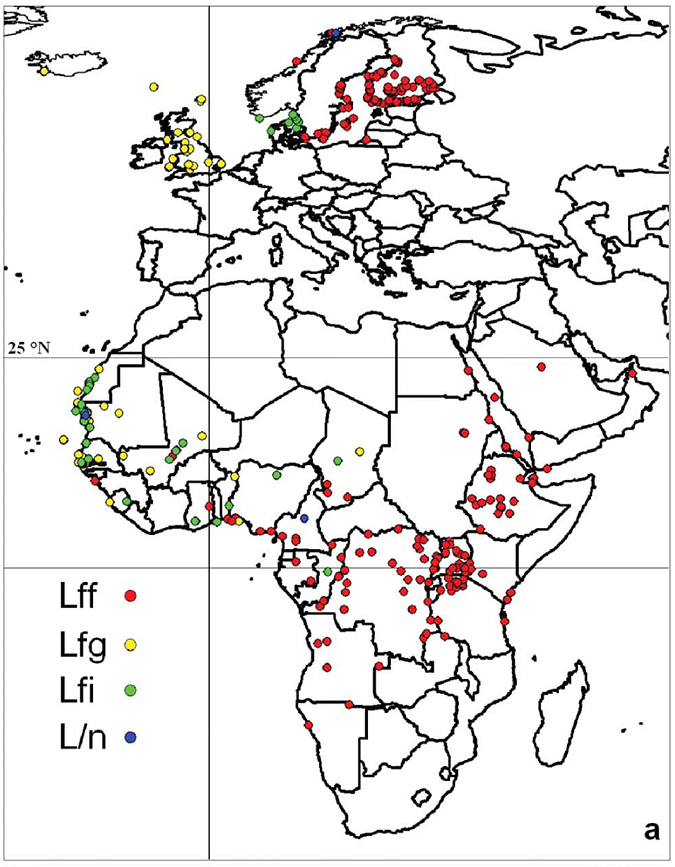
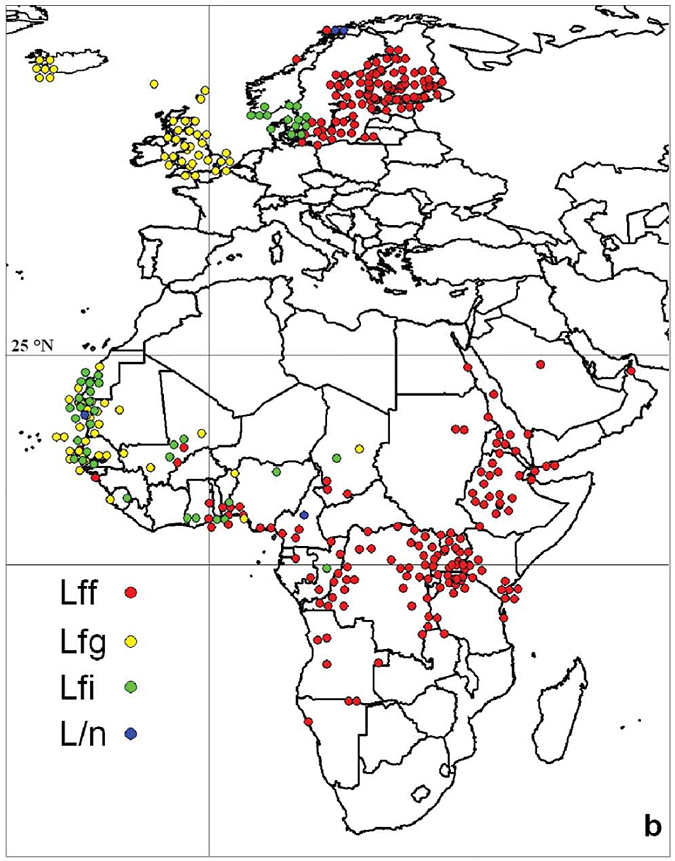
Figure 1a. Overview of ringing and recovery locations of the three subspecies of Lesser Black-backed Gulls. The lines indicate the equator and the Greenwich longitude. Lff – fuscus, Lfg – graellsii, Lfi – intermedius, L/n – uncertain fuscus or intermedius. The data from Norway is incomplete and all ringing localities in the southern part of the country are indicated from a single location although ringing occurred in much of western Norway.
b. Overview map with ringing and recovery data dispersed to reduce overlap of multiple ringings / recoveries at many locations.
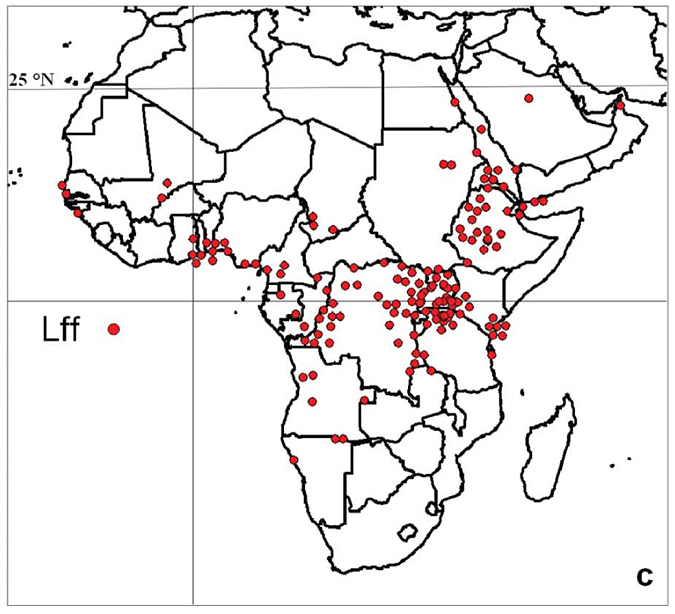
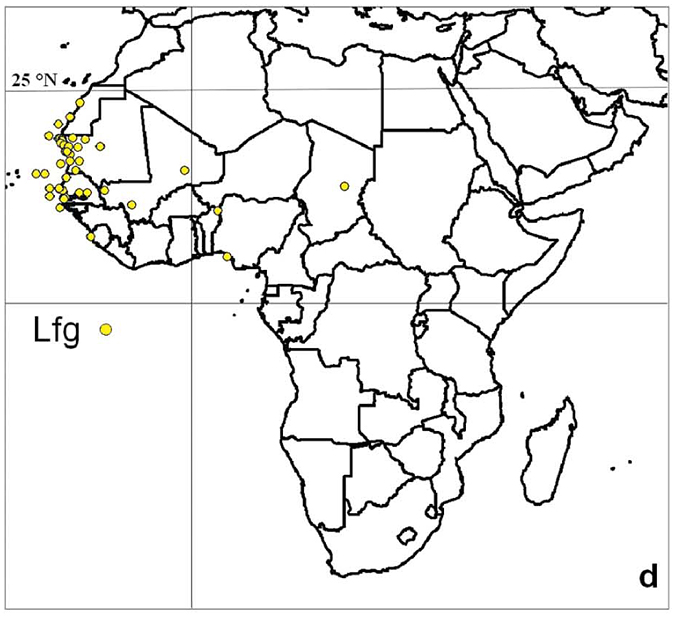
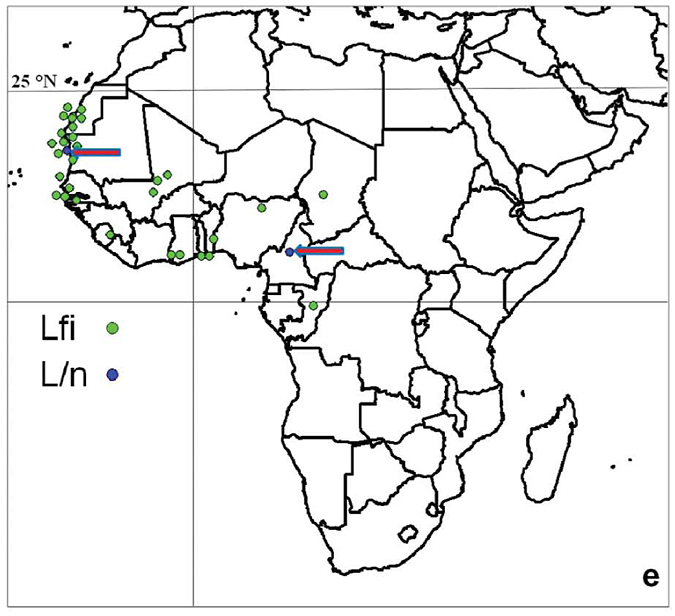
c-e. Detailed maps of the recoveries in sub-Saharan Africa of each subspecies of Lesser Black-backed Gull. c. fuscus. d. graellsii. e. intermedius plus two non-assigned (intermedius or fuscus) from northern Norway. To help locate the unassigned these dots are indicated by arrows.
RESULTS
Recoveries of 166 rings for fuscus, 82 for graellsii, and 19 for intermedius were obtained. In addition, 2, 12, and 8 collection localities were obtained for graellsii, intermedius, and fuscus respectively, from verifiable museum skins. For ease of discussion, unless otherwise qualified, we will refer to museum skins and ring recoveries as ‘recoveries’ from here on.
An overview of the 269 ringing and 283 recovery locations of individuals of all three subspecies recovered south of 25° N is given in Fig. 1a. Many birds have been ringed or recovered at locations close together causing overlap of the points on the chosen scale, why additional maps with dispersed points (with reduced overlap) are presented (Fig. 1b) to show the approximate location of each recovered bird. Points were dispersed using the ‘overlap’ feature of the mapping programme. Dispersion was maximum 30 km at the highest latitudes, and 140 km at the equator. Since all three subspecies had overlapping distributions in western Africa and to aid in interpretation of distribution, individual dispersed maps are provided (Fig. 1c-e).
Recoveries of fuscus are most dense from Ethiopia down through the African Great Lakes to the Congo basin and to the west coast of Africa from the Gulf of Guinea to Namibia (Fig.1c). There are also some fuscus recovered along the eastern seaboard.
Recoveries of both graellsii (Fig. 1d) and intermedius (Fig. 1e) are concentrated to westernmost Africa from Western Sahara to Senegal, with some distributed further east and south. Fig. 2a-b show the latitudinal and longitudinal distributions, respectively, of all three subspecies in Africa south of 25° N. For both latitude and longitude, the separation was highly significantly different (Kruskal-Wallis p< 0.0001) between fuscus and the other two subspecies (Dunn’s multiple post-hoc tests p<0.001), but not between graellsii and intermedius (p>0.05). The nominate distribution was further east and south, centring on Lake Victoria, than graellsii and intermedius, both centring on southern Mauritania.
The ring recoveries are dispersed over the whole time span of the ringing programmes while many of the museum specimens are from the 19th or early 20th century, i.e., prior to most ringing programmes. The number of recoveries of graellsii and intermedius is too low to distinguish any major shift in the wintering area. Although the number of recoveries of fuscus is higher, there is no obvious shift in the distribution in sub-Saharan Africa when the data are partitioned into recoveries per decade.
DISCUSSION
Geographic distribution
The recoveries of ringed fuscus (Fig. 1c) do only partially confirm the conventionally accepted wintering area (Britton 1986, Malling Olsen & Larsson 2004). Based on the density of recoveries (Fig. 1c) we conclude that the core wintering area of fuscus in sub-Saharan Africa is from Ethiopia over Uganda to the Congo basin and further to the Atlantic coast up to Nigeria and Ghana. Except for around Lake Victoria (the outline of which is clearly visible in Fig. 1a-c), the recoveries of fuscus east of the Albertine Rift (the western arm of the Rift Valley system) and along the eastern seaboard are surprisingly few, considering that this was considered an important wintering area (Britton 1986, Malling Olsen & Larsson 2004).
Already in the previous study (Kylin et al. 2010) we showed that the Congo basin was likely a more important wintering area for fuscus than the East African coast, based on ring recoveries from Finland and Sweden. This impression is augmented when also Danish and Norwegian data are included, although a few additional ring recoveries from the eastern seaboard were found among these newly included data. To enhance the picture, there are also a fair number of registered sightings in Namibia, Botswana, and South Africa (ADU 2010a, 2010b, Zest for Birds 2010; locations not indicated in Fig. 1) and a couple of museum specimens from Zimbabwe; individual fuscus apparently wander widely over much of the southern part of the continent. Indeed, Donnelly (1974) suggested that Lesser Black-backed Gulls are more common in southern Africa than the literature normally indicates, but that many are mistaken for Kelp Gulls (L. dominicanus). The situation on the eastern seaboard of Africa remains unclear due to the presence of a fourth taxon, L. [fuscus] heuglini. This taxon nests in Russia and we have not gained access to any relevant ringing data.
The latitudinal and longitudinal separation between fuscus on the one hand, and graellsii and intermedius on the other is pronounced (Fig. 2a-b) and significant. Harris (1962) also reported that 86% of graellsii ringed in Britain found along the west coast of Africa (down to Mauritania) were first year birds. We did not analyse for any changes over time or effects of age classes as we do not yet have complete data sets from all of Europe. It does seem from our data that in Africa, intermedius and fuscus are less constrained latitudinally and longitudinally than graellsii. Changes in local conditions as well as climate change may therefore have a greater negative effect on the wintering range of graellsii than the other two, as there may be more scope for exploratory migration in Africa to the south and east.
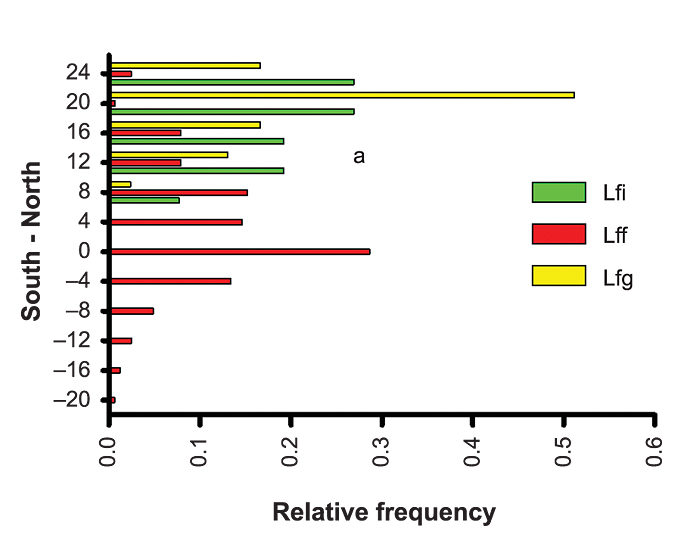

Figure 2. a) Relative latitudinal distribution of the three subspecies of Lesser Black-backed Gulls. Bin widths are 4°. b) Relative longitudinal distribution of the three subspecies of Lesser Black-backed Gulls. Bin widths are 5°. Lff – fuscus, Lfg – graellsii, Lfi – intermedius.
Migration routes
Drawing conclusions about migratory routes based on recoveries is complicated, but it is notable that only three fuscus rings (Fig 1c) have been recovered in westernmost Africa in the area where most graellsii (Fig. 1d) and intermedius (Fig. 1e) have been found while quite a few have been recovered in the inner Gulf of Guinea and along the Niger River. It is difficult to envisage that all the fuscus individuals recovered in the Gulf of Guinea and the Niger River have migrated via the western flyway as sometimes suggested (Cramp & Simmons 1983). Rather, it is noteworthy that these recoveries more or less lie within a contiguous area of ring recoveries extending between Lake Victoria, across the Congo basin to Namibia and the Niger River/Gulf of Guinea. This pattern of recoveries makes migration along an eastern flyway (Åkesson 2010), via the Congo basin to the Atlantic likely, although some may also migrate directly across the Sahara (Schmaljohann et al. 2008). That migration across deserts does occur is obvious from a ring recovered in central Saudi Arabia. Although this bird was recovered in a farming area with artificial irrigation, it must have flown over desert to reach the location. A low number of fuscus will clearly migrate along the western flyway as observed, e.g., in Portugal (Marques et al. 2009), but given the great variability of plumage colouring in colonies normally attributed to intermedius (Noeske 2008) some of the birds reported as fuscus off Portugal may be of another subspecies.
Although the ring recoveries of graellsii and intermedius are concentrated to westernmost Africa (95% and 62% between 27°30' and 17°30' W for graellsii and intermedius, respectively), some clearly migrate further east and south from the core wintering area (Fig. 1d-e, Fig. 2a-b). The latitudinal ring recovery distribution (Fig. 2b) indicates that a larger percentage of intermedius than of graellsii move on, especially further east. It must be pointed out, though, that our material suffers from an incomplete dataset of intermedius ringed in Norway pending an ongoing national evaluation. Once these data become available the complete picture may become clearer. Presently, the only ring recovery south of the equator of either of these two subspecies is an intermedius recovered at 0°27' S in the Republic of the Congo (Brazzaville; Fig. 1e). Thus, the statement by Lippens & Wille (1976) that all three subspecies are present in the Congo basin is not supported by recoveries. If subspecies other than fuscus are present in the Congo basin this would in all likelihood be low numbers of intermedius. Likewise, in contrast to the statements of Ajonina et al. (2007) that equal numbers of fuscus and graellsii occur off Cameroon, the recoveries indicate that fuscus and intermedius dominate, while the number of graellsii should be lower.
Analyzing the ringing localities give additional interesting information on the migration behaviour of the western subspecies of the Lesser Black-backed Gull. All recovered graellsii south of 25° N were ringed in Britain, the Shetland and Faeroe Islands, and Iceland, while recoveries of birds ringed in Ireland are absent (Fig. 1a-b). Similarly, all recovered intermedius were ringed in Denmark, Norway, and Sweden, while birds ringed further south in continental Europe have not been recovered south of the Sahara, e.g., from 447 colour-ringed nestling birds and 39 breeding adults in the colony in Belgium, only two sightings (on a grand total of 3395) were made in Mauritania, one in Senegal and none further south (Van Waeyenberge et al. 2002). Collectively, the sightings and recoveries indicate leapfrog migration where individuals nesting in the north of the nesting area of the respective subspecies migrate further south than those nesting in the south. This can also be seen by comparing Figs. 1b and 2a where fuscus that breed further north than the other two subspecies are recovered further south. This pattern could, however, also be due to geography, where birds breeding in European Scandinavia, when flying south, end up in eastern and central Africa as they seemingly skirt the drier Sahel. For graellsii and intermedius, the Gulf of Guinea limits any movement further south (Figs. 1d, 1e & 2a).
When more ringing and recovery data becomes available, these patterns can be studied in more detail.
Field observations and museum specimens
There are published field observations that suggest the occurrence of graellsii in Angola. Günther & Feiler (1986) tentatively assigned a flock of 12 foraging Lesser Black-backed Gulls observed just north of Luanda in Angola to graellsii. However, when checking the reference given as basis for the determination (Tuck & Heinzel 1978) it contains major errors. We have checked 12 individual copies of both the first (1978) and second (1980) printing of this book and find that the printing quality of the plates varies and in many of them the mantle of graellsii is depicted too dark. But, most importantly, the available distribution maps contain errors showing graellsii as the only subspecies wintering in Africa while fuscus is shown wintering in the North Atlantic (intermedius is not mentioned). It is, therefore, possible, if not likely, that the assignment of the observed birds to graellsii is based on faulty information and that they actually were fuscus. On direct question, the senior author agreed that this conjecture is plausible (Rainer Günther, pers. comm.), but that it has been too long since the observations were made for him to remember clearly how the discussions then went.
There is also a museum specimen from Angola; a juvenile bird collected in 1900 determined as graellsii (Dean 2000). But when inspected even the species determination of the specimen is doubtful. Our conclusion, therefore, is that there is no clear evidence from ring recoveries, verifiable museum specimens or published field observations, that graellsii or intermedius occur to any great extent south of the equator.
Additional information, especially on past distributions, could be gained from skins of juvenile specimens in museum collections if it was possible to use genetic markers to distinguish the subspecies of Lesser Black-backed Gull. Unfortunately, this does not currently seem to be possible (Liebers et al. 2004).
Feeding ecology Strann & Vader (1992) studied the differences in feeding behaviour between the subspecies of Lesser Black-backed Gull. They suggested that fuscus has adapted a feeding behaviour, catching small fish at the water surface, that allow them to avoid competition with both other large gull species (e.g., L. argentatus and L. marinus) and the other subspecies of Lesser Black-backed Gull that all aggregate around major food sources such as fishing boats and garbage dumps. We observed fuscus feeding on small fish between the trees of the flooded forest of the Congo basin (Kylin et al. 2010). Most of the fish productivity in this area is in the flooded forest, less so in bodies of open water (Marlier 1958), and it is possible that this feeding adaptation has enabled fuscus to utilize the flooded forest in ways that the other subspecies will not. If so, the large tracts of flooded forest in the Congo basin could act as a geographic barrier where intermedius and graellsii have difficulties finding sufficient food, but allowed fuscus to disperse more widely in and beyond the Congo basin (compare distributions Fig 1c-e).
CONCLUSIONS
Although the EURING dataset is incomplete, the number of data is reasonable and the general distribution picture should not change substantially even with complete data from all countries. We are not suggesting that the area where rings have been recovered of an individual subspecies is the whole extent of its wintering range, but that the density of ring recoveries has substantial indicative value. If a high number of rings of one subspecies have been recovered in an area, but no rings of other subspecies, this should give valuable information on the relative abundance of the subspecies over time. For Africa as a whole there are many additional recoveries of Lesser Black-backed Gulls further north (EURING 2010), including birds ringed further south in Europe. But our focus has been to understand the distribution of the subspecies south of the Sahara, why we exclude any such information here. In addition to Africa, fuscus disperses around the Arabian Peninsula south of 25° N (Fig. 1a-c).
We have updated the distribution of fuscus, graellsii and intermedius in Africa south of 25° N based on rings recovered from birds ringed as pulli, and visually verified museum specimens. Fuscus show a high density of recoveries in an area stretching in an arc from Ethiopia, over Lake Victoria and through the Congo basin to the Gulf of Guinea, with some recoveries south into Angola and Namibia. The previously suggested wintering area along the east coast of Africa for this subspecies seems less important than the Congo basin and the western seaboard. Distribution of the other two subspecies, graellsii and intermedius, are concentrated in western Africa, with some inland towards the east and south. The southernmost ring recovery of either of these two, an intermedius, was on the equator in the Republic of the Congo (Brazzaville). Some museum specimens and field observations of graellsii south of the Equator are doubtful, and we have not found any verifiable evidence (either ringed as pulli or visually confirmed museum skins) of any subspecies other than for fuscus south of the equator. Climate change might have a greater effect on graellsii and intermedius, as they seem to be more constrained in available landmass to the south than fuscus, but might shift farther southwest along the coast.
ACKNOWLEDGEMENTS
Particular thanks are due to Chris du Feu at the EURING databank for valuable help and providing most of the ringing data. Klaus Malling Olsen and Hans Larsson gave valuable comments on photos of museum specimens. Additional ringing data were provided by Wolfgang Fiedler from the German ringing programme, Morten Helberg and Alf Tore Mjøs from the Norwegian ringing programme, Ævar Petersen from the Icelandic ringing programme, William Velmala from the Finnish ringing programme, and Thomas Wenninger from the Swedish ringing programme. Hein van Grouw, British Museum of Natural History, Alain Reygel, Royal Museum for Central Africa (Belgium), Paul Sweet and Thomas J. Trombone, American Museum of Natural History, Tamar Cassidy from the Transvaal Museum, Pretoria, South Africa, and Peter Mundy, Bulawayo, Zimbabwe, helped locate museum specimens or providing photos thereof. The staff of several other museums also searched their holdings for relevant specimens. Valuable discussion points were provided by Inogwabini Bila-Isai (WWF Congo), Richard Dean, and Rainer Günther. The text was much improved by two reviewers. The authors declare they have no conflict of interest.
REFERENCES
ADU 2010a. Animal Demography Unit, University of Cape Town. Accessed 20 August 2010
ADU 2010b. Animal Demography Unit, University of Cape Town. Accessed 20
August 2010
Ajonina, G., Napoleon, C., Skeen, R. & van der Waarde, J. 2007. Waterbird Census of Coastal Cameroon and Sanaga River. WIWO Report Series 83.
Åkesson, S. 2010. Accessed
18 July 2010
Bakken, V., Runde, O. & Tjørve, E. 2003. Norsk ringmerkingsatlas. Vol. 1: 338-346 (in Norwegian with English summary). Stavanger Museum, Stavanger, Norway.
Britton, P.L. 1986. Laridae. In Urban EK, Fry CH, Keith S (eds) The Birds of Africa. Vol 2: 340-374. Academic Press, London.
Cramp, S. & Simmons, K.E.L. (eds) 1983. Birds of the Western Palaearctic. Vol 3: 801-815. Oxford University Press, London.
Crochet, P.-A., Lebreton, J.D. & Bonhomme, F. 2002. Systematics of Large white-headed Gulls: Patterns of Mitochondrial DNA Variation in Western European Taxa. Auk 119: 603–620.
Dean, W.R.J. 2000. The Birds of Angola: An Annotated Checklist. BOU Checklist 18. British Ornithologists’ Union, Tring.
Donnelly, B.G. 1974. The Lesser Black-backed Gull Larus fuscus in southern and central Africa. Bull. Brit. Ornith. Club 94: 63–68.
EURING 2010. Accessed 17 June
2010
FMNH 2010. Finnish Museum of Natural History, bird ringing centre.
Accessed 15 July 2010
Günther, R. & Feiler, A. 1986. Zur Phänologie, Ökologie und Morphologie angolanischer Vögel (Aves). Teil I: Non-Passeriniformes. Faunist. Abhand. Staat. Mus. Tierk. Dresden 13: 189–227 (in German).
Jonsson, L. 1998. Baltic Lesser Black-backed Gull Larus fuscus fuscus – moult, ageing and identification. Birding World 11: 295–317.
Harris, M.P. 1962. Migration of the Lesser Black-backed Gull as shown by ringing data. Bird Study 9: 174-182.
Helberg, M., Systad, G.H., Birkeland, I., Lorentzen, N.H. & Bustnes, J.O. 2009. Migration patterns of adult and juvenile Lesser Black-backed Gulls Larus fuscus from northern Norway. Ardea 97: 281-286.
Kylin, H., Louette, M., Herroelen, P. & Bouwman, H. 2010. Nominate Lesser Black-backed Gulls (Larus fuscus fuscus) winter in the Congo basin. Ornis Fenn. 87: 106-113.
Liebers, D., Helbig, A.J. & de Knijff, P. 2001. Genetic differentiation and phylogeography of gulls in the Larus cachinnans-fuscus group (Aves: Charadriiformes). Mol. Ecol. 10: 2447–2462.
Liebers, D. & Helbig, A.J. 2002. Phylogeography and colonization history of Lesser Black-backed Gulls (Larus fuscus) as revealed by mtDNA sequences. J. Evol. Biol. 15: 1021–1033.
Liebers, D., de Knijff, P. & Helbig, A.J. 2004. The herring gull complex is not a ring species. Proc. Roy. Soc. London, Ser. B – Biol. Sci. 271: 893–901.
Lippens, L. & Wille, H. 1976. Les Oiseaux du Zaïre. Lannoo, Tielt, Belgium (in French).
Malling Olsen, K. & Larsson, H. 2004. Gulls of Europe, Asia and North America. Christopher Helm, London.
Marlier, G. 1958. Recherches hydrobiologiques au lac Tumba. Hydrobiologia 10: 352-385.
Marques, P.A.M., Costa, A.M., Rock, P. & Jorge, P.E. 2009. Age-related migration patterns in Larus fuscus spp. Acta Ethol. 12: 87–92.
Noeske, A. 2008. Mantelfärbung und taxonomische Stellung der Heringsmöwen Larus fuscus auf Amrum. Vogelwelt 129: 379–394 (in German with English summary).
Schmaljohann, H., Liechti, F. & Bruderer, B. 2008. First record of lesser black-backed gulls Larus fuscus crossing the Sahara non-stop. J. Avian. Biol. 39: 233-237.
SMNH 2010. Swedish Museum of Natural History Bird Ringing Centre. Accessed
15 July 2010
Strann, K.-B. & Vader, W. 1992. The nominate Lesser Black-backed Gull Larus fuscus fuscus, a gull with a tern-like feeding biology, and its recent decrease in northern Norway. Ardea 80: 133–142.
Tuck, G. & Heinzel, H. 1978. A Field Guide to the Seabirds of Britain and the World. William Collins Sons & Co.
Van Waeyenberge, J., Stienen, E.W.M. & Vercruijsse, H.J.P. 2002. Kleurringproject van Zilvermeeuw Larus argentatus en Kleine Mantelmeeuw Larus fuscus aan de Belgische kust: overzicht van algemene resultaten. Natuur.oriolus 68: 146-156 (in Dutch with English summary).
Yesou, P. 2002. Systematics of Larus argentatus-cachinnans-fuscus complex revisited. Dutch Birding 24: 271–298.
Zest for Birds 2010. (Rarities page) Accessed 30 May 2010
Table adult February
Table showing old and new primaries in adult fuscus in February; data for Israel (2008-2011).
P6 new = P6 longest new primary; it exceeds the previous primary in length (so P6 new / fully grown, only from the moment when it is longer than P5).
PMS |
P8 new |
P9 new |
P10 new |
total |
no old |
1 |
7 |
5 |
13 |
 L. f. fuscus adult C2K6 February 26 2009, Ashdod, Israel. Picture: Amir Ben Dov. Primary moult finished.
L. f. fuscus adult C2K6 February 26 2009, Ashdod, Israel. Picture: Amir Ben Dov. Primary moult finished. L. f. fuscus 15cy C3N5 February 26 2011, Ashdod, Israel. Picture: Amir Ben Dov. Also seen in January 2010.
L. f. fuscus 15cy C3N5 February 26 2011, Ashdod, Israel. Picture: Amir Ben Dov. Also seen in January 2010. L. f. fuscus adult C3Y1 February 2008 & 2011, Ashdod, Israel. Picture: Amir Ben Dov.Also seen in November 2009.
L. f. fuscus adult C3Y1 February 2008 & 2011, Ashdod, Israel. Picture: Amir Ben Dov.Also seen in November 2009. L. f. fuscus adult C4NX February 29 2012, Ashdod, Israel. Picture: Amir Ben Dov.
L. f. fuscus adult C4NX February 29 2012, Ashdod, Israel. Picture: Amir Ben Dov. L. f. fuscus 13cy C5P4 February 10 2009, Ashdod, Israel. Picture: Amir Ben Dov.
L. f. fuscus 13cy C5P4 February 10 2009, Ashdod, Israel. Picture: Amir Ben Dov. L. f. fuscus 13cy C5Y2 February 15 2008, Ashdod, Israel. Picture: Amir Ben Dov.
L. f. fuscus 13cy C5Y2 February 15 2008, Ashdod, Israel. Picture: Amir Ben Dov. L. f. fuscus adult C6KC February 26 2011, Ashdod, Israel. Picture: Amir Ben Dov.
L. f. fuscus adult C6KC February 26 2011, Ashdod, Israel. Picture: Amir Ben Dov. L. f. fuscus adult C6EH February 26 2011, Ashdod, Israel. Picture: Amir Ben Dov.
L. f. fuscus adult C6EH February 26 2011, Ashdod, Israel. Picture: Amir Ben Dov. L. f. fuscus 13cy C9S0 February 04-26 2011, Ashdod, Israel. Picture: Amir Ben Dov.
L. f. fuscus 13cy C9S0 February 04-26 2011, Ashdod, Israel. Picture: Amir Ben Dov. L. f. fuscus adult C953 February 26 2011, Ashdod, Israel. Picture: Amir Ben Dov.
L. f. fuscus adult C953 February 26 2011, Ashdod, Israel. Picture: Amir Ben Dov.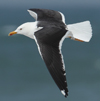 L. f. fuscus adult CAPR February 26 2011, Ashdod, Israel. Picture: Amir Ben Dov.
L. f. fuscus adult CAPR February 26 2011, Ashdod, Israel. Picture: Amir Ben Dov. L. f. fuscus 13cy CHV8 February 2008 & 2011, Ashdod, Israel. Picture: Amir Ben Dov.
L. f. fuscus 13cy CHV8 February 2008 & 2011, Ashdod, Israel. Picture: Amir Ben Dov. L. f. fuscus 13cy CJP3 February 12 2011, Ashdod, Israel. Picture: Amir Ben Dov.
L. f. fuscus 13cy CJP3 February 12 2011, Ashdod, Israel. Picture: Amir Ben Dov. L. f. fuscus 13cy C516 February 15 2008, Ashdod, Israel. Picture: Amir Ben Dov.
L. f. fuscus 13cy C516 February 15 2008, Ashdod, Israel. Picture: Amir Ben Dov. L. f. fuscus 13cy C910 February 15 2008, Ashdod, Israel. Picture: Amir Ben Dov.
L. f. fuscus 13cy C910 February 15 2008, Ashdod, Israel. Picture: Amir Ben Dov. L. f. fuscus adult CUNA February 2011 & 2012, Ashdod, Israel. Picture: Amir Ben Dov.
L. f. fuscus adult CUNA February 2011 & 2012, Ashdod, Israel. Picture: Amir Ben Dov. L. f. fuscus 13cy CWWR February 04 2011, Ashdod, Israel. Picture: Amir Ben Dov.
L. f. fuscus 13cy CWWR February 04 2011, Ashdod, Israel. Picture: Amir Ben Dov. L. f. fuscus 5cy CJL1 February 12 2011, Ashdod, Israel. Picture: Amir Ben Dov.
L. f. fuscus 5cy CJL1 February 12 2011, Ashdod, Israel. Picture: Amir Ben Dov. L. f. fuscus 4cy-6cy CC14 January 2008 & February 2009, Ashdod, Israel. Pictures: Amir Ben Dov. Primary moult finished.
L. f. fuscus 4cy-6cy CC14 January 2008 & February 2009, Ashdod, Israel. Pictures: Amir Ben Dov. Primary moult finished. L. f. fuscus adult CV03 February 2008 & 2009, Ashdod, Israel. Pictures: Amir Ben Dov. End of primary moult.
L. f. fuscus adult CV03 February 2008 & 2009, Ashdod, Israel. Pictures: Amir Ben Dov. End of primary moult. L. f. fuscus adult CY79 February 26 2009, Ashdod, Israel. Picture: Amir Ben Dov. End of primary moult.
L. f. fuscus adult CY79 February 26 2009, Ashdod, Israel. Picture: Amir Ben Dov. End of primary moult. L. f. fuscus 13cy HT-168225 February 2011 & December 2012, Ashdod, Israel. Picture: Amir Ben Dov.
L. f. fuscus 13cy HT-168225 February 2011 & December 2012, Ashdod, Israel. Picture: Amir Ben Dov.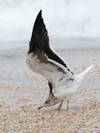 L. f. fuscus adult J0X0 February 2008, 2009 & 2011, Ashdod, Israel. Pictures: Amir Ben Dov.
L. f. fuscus adult J0X0 February 2008, 2009 & 2011, Ashdod, Israel. Pictures: Amir Ben Dov. heuglini / fuscus 5CY U0JD 2010-2014, Ashdod, Israel. Picture: Amir Ben Dov & April 2013 Poland, Picture: Mariusz Dabek.
heuglini / fuscus 5CY U0JD 2010-2014, Ashdod, Israel. Picture: Amir Ben Dov & April 2013 Poland, Picture: Mariusz Dabek.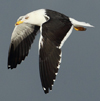 L. f. fuscus adult, February 29 2012, Ashdod, Israel. Picture: Amir Ben Dov. Active moult in P1.
L. f. fuscus adult, February 29 2012, Ashdod, Israel. Picture: Amir Ben Dov. Active moult in P1. L. f. fuscus adult, February 04 2011, Ashdod, Israel. Picture: Amir Ben Dov.
L. f. fuscus adult, February 04 2011, Ashdod, Israel. Picture: Amir Ben Dov. L. f. fuscus adult, February 04 2011, Ashdod, Israel. Picture: Amir Ben Dov.
L. f. fuscus adult, February 04 2011, Ashdod, Israel. Picture: Amir Ben Dov. L. f. fuscus adult, February 04 2011, Ashdod, Israel. Picture: Amir Ben Dov.
L. f. fuscus adult, February 04 2011, Ashdod, Israel. Picture: Amir Ben Dov. L. f. fuscus adult, February 12 2011, Ashdod, Israel. Picture: Amir Ben Dov.
L. f. fuscus adult, February 12 2011, Ashdod, Israel. Picture: Amir Ben Dov. L. f. fuscus adult, February 19 2011, Ashdod, Israel. Picture: Amir Ben Dov.
L. f. fuscus adult, February 19 2011, Ashdod, Israel. Picture: Amir Ben Dov. L. f. fuscus adult, February 19 2011, Ashdod, Israel. Picture: Amir Ben Dov.
L. f. fuscus adult, February 19 2011, Ashdod, Israel. Picture: Amir Ben Dov. L. f. fuscus adult, February 19 2011, Ashdod, Israel. Picture: Amir Ben Dov.
L. f. fuscus adult, February 19 2011, Ashdod, Israel. Picture: Amir Ben Dov. L. f. fuscus adult, February 26 2011, Ashdod, Israel. Picture: Amir Ben Dov.
L. f. fuscus adult, February 26 2011, Ashdod, Israel. Picture: Amir Ben Dov.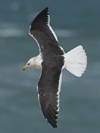 L. f. fuscus adult, February 26 2011, Ashdod, Israel. Picture: Amir Ben Dov.
L. f. fuscus adult, February 26 2011, Ashdod, Israel. Picture: Amir Ben Dov. L. f. fuscus adult, February 26 2011, Ashdod, Israel. Picture: Amir Ben Dov.
L. f. fuscus adult, February 26 2011, Ashdod, Israel. Picture: Amir Ben Dov. L. f. fuscus adult, February 26 2011, Ashdod, Israel. Picture: Amir Ben Dov.
L. f. fuscus adult, February 26 2011, Ashdod, Israel. Picture: Amir Ben Dov. L. f. fuscus adult, February 26 2011, Ashdod, Israel. Picture: Amir Ben Dov.
L. f. fuscus adult, February 26 2011, Ashdod, Israel. Picture: Amir Ben Dov. L. f. fuscus adult, February 26 2011, Ashdod, Israel. Picture: Amir Ben Dov.
L. f. fuscus adult, February 26 2011, Ashdod, Israel. Picture: Amir Ben Dov. L. f. fuscus adult, February 26 2011, Ashdod, Israel. Picture: Amir Ben Dov.
L. f. fuscus adult, February 26 2011, Ashdod, Israel. Picture: Amir Ben Dov.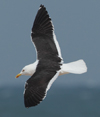 L. f. fuscus adult, February 26 2011, Ashdod, Israel. Picture: Amir Ben Dov.
L. f. fuscus adult, February 26 2011, Ashdod, Israel. Picture: Amir Ben Dov.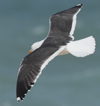 L. f. fuscus adult, February 26 2011, Ashdod, Israel. Picture: Amir Ben Dov.
L. f. fuscus adult, February 26 2011, Ashdod, Israel. Picture: Amir Ben Dov. L. f. fuscus adult, February 26 2011, Ashdod, Israel. Picture: Amir Ben Dov.
L. f. fuscus adult, February 26 2011, Ashdod, Israel. Picture: Amir Ben Dov. L. f. fuscus adult, February 26 2011, Ashdod, Israel. Picture: Amir Ben Dov.
L. f. fuscus adult, February 26 2011, Ashdod, Israel. Picture: Amir Ben Dov. L. f. fuscus adult, February 26 2011, Ashdod, Israel. Picture: Amir Ben Dov.
L. f. fuscus adult, February 26 2011, Ashdod, Israel. Picture: Amir Ben Dov. L. f. fuscus adult, February 26 2011, Ashdod, Israel. Picture: Amir Ben Dov.
L. f. fuscus adult, February 26 2011, Ashdod, Israel. Picture: Amir Ben Dov. L. f. fuscus adult, February 26 2011, Ashdod, Israel. Picture: Amir Ben Dov.
L. f. fuscus adult, February 26 2011, Ashdod, Israel. Picture: Amir Ben Dov. L. f. fuscus adult, February 26 2011, Ashdod, Israel. Picture: Amir Ben Dov.
L. f. fuscus adult, February 26 2011, Ashdod, Israel. Picture: Amir Ben Dov.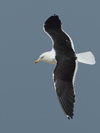 L. f. fuscus adult, February 26 2011, Ashdod, Israel. Picture: Amir Ben Dov.
L. f. fuscus adult, February 26 2011, Ashdod, Israel. Picture: Amir Ben Dov. L. f. fuscus adult, February 26 2011, Ashdod, Israel. Picture: Amir Ben Dov.
L. f. fuscus adult, February 26 2011, Ashdod, Israel. Picture: Amir Ben Dov.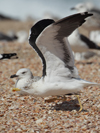 L. f. fuscus adult, February 26 2011, Ashdod, Israel. Picture: Amir Ben Dov.
L. f. fuscus adult, February 26 2011, Ashdod, Israel. Picture: Amir Ben Dov. L. f. fuscus adult, February 26 2011, Ashdod, Israel. Picture: Amir Ben Dov.
L. f. fuscus adult, February 26 2011, Ashdod, Israel. Picture: Amir Ben Dov. L. f. fuscus adult, February 26 2011, Ashdod, Israel. Picture: Amir Ben Dov.
L. f. fuscus adult, February 26 2011, Ashdod, Israel. Picture: Amir Ben Dov.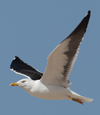 L. f. fuscus adult, February 26 2011, Ashdod, Israel. Picture: Amir Ben Dov.
L. f. fuscus adult, February 26 2011, Ashdod, Israel. Picture: Amir Ben Dov. L. f. fuscus adult, February 26 2011, Ashdod, Israel. Picture: Amir Ben Dov.
L. f. fuscus adult, February 26 2011, Ashdod, Israel. Picture: Amir Ben Dov. L. f. fuscus adult, February 26 2011, Ashdod, Israel. Picture: Amir Ben Dov.
L. f. fuscus adult, February 26 2011, Ashdod, Israel. Picture: Amir Ben Dov. L. f. fuscus adult, February 26 2011, Ashdod, Israel. Picture: Amir Ben Dov.
L. f. fuscus adult, February 26 2011, Ashdod, Israel. Picture: Amir Ben Dov.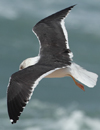 L. f. fuscus adult, February 26 2011, Ashdod, Israel. Picture: Amir Ben Dov.
L. f. fuscus adult, February 26 2011, Ashdod, Israel. Picture: Amir Ben Dov.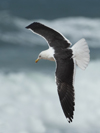 L. f. fuscus adult, February 26 2011, Ashdod, Israel. Picture: Amir Ben Dov.
L. f. fuscus adult, February 26 2011, Ashdod, Israel. Picture: Amir Ben Dov. L. f. fuscus adult, February 26 2011, Ashdod, Israel. Picture: Amir Ben Dov.
L. f. fuscus adult, February 26 2011, Ashdod, Israel. Picture: Amir Ben Dov.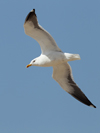 L. f. fuscus adult, February 26 2011, Ashdod, Israel. Picture: Amir Ben Dov.
L. f. fuscus adult, February 26 2011, Ashdod, Israel. Picture: Amir Ben Dov. L. f. fuscus adult, February 26 2011, Ashdod, Israel. Picture: Amir Ben Dov.
L. f. fuscus adult, February 26 2011, Ashdod, Israel. Picture: Amir Ben Dov. L. f. fuscus adult, February 26 2011, Ashdod, Israel. Picture: Amir Ben Dov.
L. f. fuscus adult, February 26 2011, Ashdod, Israel. Picture: Amir Ben Dov. L. f. fuscus adult, February 26 2011, Ashdod, Israel. Picture: Amir Ben Dov.
L. f. fuscus adult, February 26 2011, Ashdod, Israel. Picture: Amir Ben Dov. L. f. fuscus adult, February 26 2011, Ashdod, Israel. Picture: Amir Ben Dov.
L. f. fuscus adult, February 26 2011, Ashdod, Israel. Picture: Amir Ben Dov. L. f. fuscus adult, February 26 2011, Ashdod, Israel. Picture: Amir Ben Dov.
L. f. fuscus adult, February 26 2011, Ashdod, Israel. Picture: Amir Ben Dov. L. f. fuscus adult, February 26 2011, Ashdod, Israel. Picture: Amir Ben Dov.
L. f. fuscus adult, February 26 2011, Ashdod, Israel. Picture: Amir Ben Dov.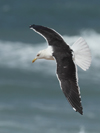 L. f. fuscus adult, February 26 2011, Ashdod, Israel. Picture: Amir Ben Dov.
L. f. fuscus adult, February 26 2011, Ashdod, Israel. Picture: Amir Ben Dov. L. f. fuscus adult, February 26 2011, Eilat, Israel. Picture: Avi Meir.
L. f. fuscus adult, February 26 2011, Eilat, Israel. Picture: Avi Meir. L. f. fuscus adult, February 03 2012, Eilat, Israel. Picture: Avi Meir.
L. f. fuscus adult, February 03 2012, Eilat, Israel. Picture: Avi Meir.